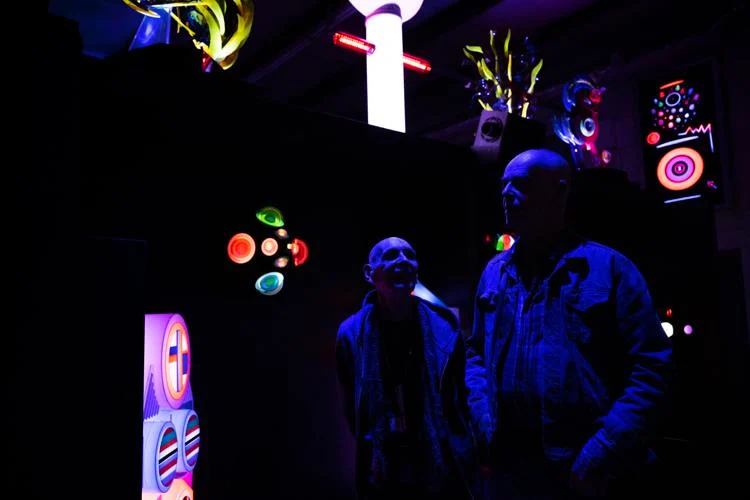By KELLY HAYES kelly.hayes@gazette.com Jan 7, 2024


Surrounded by the sculptures of Lumonics late founders Dorothy and Mel Tanner, publicist and co-archivist Barry Raphael and Lumonics Studio and Lumonics Immersed creative director Marc Billard stand for a photo in the gallery used for the immersive light and sound show in Denver, Colo. (Timothy Hurst/Denver Gazette)
Entering Lumonics Gallery in Denver is like walking onto a spaceship.
Flows of neon line the futuristic gallery. Bright greens, pinks and blues guide the eye. Some of the colors roam free on sculptures, while others are confined by black frames.
When the immersive show begins, it’s as if the spaceship is gearing up for take off. The artwork begins to talk by flashing light. Music plays on speakers and kaleidoscope-like imagery is projected. It’s trippy, for sure.
Founded in 1963 by the late husband-and-wife duo Mel and Dorothy Tanner, Lumonics is the longest running light-art project in the U.S. The studio gallery in Denver is home to the collection of more than 200 of the Tanners’ original works, spanning over 50 years.
“I’ve been looking at them for so many years and I still see new stuff,” said co-archivist and co-curator Barry Raphael.
The multimedia gallery rotates about 75 pieces for display. The illuminated sculptures are characterized by clean neon colors, black acrylic framing and sharp geometric shapes.

Surrounded by the sculptures of Lumonics late founders Dorothy and Mel Tanner, publicist and co-archivist Barry Raphael stands in the larger space used for the immersive show before creative director Marc Billard, not pictured, puts on a shortened immersive show on Tuesday, Dec. 19, 2023, at the Lumonics Light & Sound Gallery in Denver, Colo. (Timothy Hurst/Denver Gazette)
The Tanners started Lumonics at a warehouse in Miami during the 1960s. The concept of illuminated art was realized by the couple in response to an experience Mel had seeing light reflecting off an airplane wing.
“Mel started as a painter, and to get into sculpture was really something,” Raphael said. “Dorothy’s background was working with wood and metal and everything. She didn’t want to do the same thing as Mel.”
The choice to use acrylic glass, which is a significant component in most of their works, started with a commission. From there, it would be the duo’s medium of choice.
“General Electric asked them to create a sculpture to house the pacemaker. They chose the material acrylic glass, also known as plexiglass, which was and still is considered an industrial material — until the Tanners and other artists recognized its value as an art material, with its light transmitting quality, lightness in weight and durability,” Raphael says in a short documentary on Lumonics.
Then, in 1969, the Tanners began experimenting with more immersive experiences, blending light and sound.
Raphael began working with Lumonics in 1972, when he discovered the studio in Miami. Since the passing of the Tanners — Mel in 1993 and Dorothy in 2020 — Raphael has run the studio and works as the administrator of the Lumonics School of Light Art.
“I had been teaching language arts in junior high school, and I had heard about this in Miami, and I visited them,” Raphael said. “I was so taken with the experience, with meeting the artists that I asked if I could volunteer.”
Dorothy, along with the Lumonics collection and studio team, moved to Denver in 2008. Since her passing, Raphael hosts and co-produces Lumonics Immersed, which combines the artwork with sound and projection to create a multi-sensory experience.
No one show is the same, Raphael said. The immersive experience is orchestrated in real-time by creative director Marc Billard, who worked closely with Mel and Dorothy. Like Raphael, Billard also joined the team in 1972 after attending a Lumonics show.
Billard works in a small, hidden corner to produce the shows, surrounded by switches and screens. This control center allows Billard to choreograph the lit sculptures and project videos live, creating a unique audio/visual experience.
“Mel and Dorothy actually had a more primitive system, but 50 years ago, they were doing this,” Raphael said. Using an overhead projector, the Tanners would project images live while putting on the lights show.
As technology progressed, so did the art form. For example, the invention of LED lights in the 1990s changed how Dorothy created her sculptures.
“Mostly her works were externally lighted while Mel was alive, then after Mel died the LEDs started to coming out,” Raphael said. “LEDs really changed things, low heat, low energy.”
Part of the art’s mission is to explore the healing properties of lights and sounds, Raphael said.
“I guess what’s really kept us going is the fact that it’s not just doing art. It’s looking to combine the light art that we do and music to bring people to a better healing place,” Dorothy says in the documentary.
As far as sharing the art form with future generations, the studio hosts field trips and workshops with the Lumonics School of Light Art, co-founded by Dorothy and Billard back in 2018. There, students can work off of an illuminated cube to create their own art pieces.
“This is kind of the building block of the art form. Dorothy and Mel started building cubes in the mid-1960s, and then they electrified it. That’s how it all got underway,” Raphael said.
The Tanner’s artwork was selected as the opening exhibit in The Galleri at Meow Wolf Denver’s Convergence Station. The school will also work with a group of designers from Denver’s Meow Wolf to teach about light-art.
Details
Lumonics Light and Sound Gallery, 800 E. 73rd Ave. Unit 11, Denver, is open by appointment. More information can be found at lumonics.net or by calling 303-568-9406.
article link
